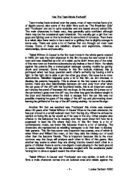In each of the films, teenagers were represented as all being social misfits who couldn’t get along with their parents or each other. The main characters from both films had similar roles; Jim Stark in “Rebel without a Cause”, and John Bender in the breakfast club, both played the role of the school rebel. Claire Standish1, and Judy2 played the role of the school princess in each of the films. Of course every school has a school geek, and this film was no exception. They are Brian Johnson1 and Plato2.
Unlike most other teenagers, the stereotypical geek always wants to stick to the rules and he always gets good grades. This is why Brian in “The Breakfast Club” chooses not to smoke marijuana when most of the detention group is, it would have been totally out of character for him to even think of doing such a thing. He is also identifiable by the way he dresses. The Princess is identifiable by her looks, which is a feature of both films, and by her popularity. In “The Breakfast Club”, another example is that John Bender and Andrew both fancy her, and being popular with the boys is another feature of “the princess”. The rebel is identifiable by his actions. He is usually always breaking rules and being mean to people. This is shown in both films; in “The Breakfast Club”, it features when John Bender is smoking Marijuana, and when he is constantly rude to the teacher. He is not very nice to the other people in his detention either. In “Rebel without a Cause”, it is shown when Jim is hiding from the police, in the planetarium. In rebel without a cause, teenagers are represented more as trouble makers, and people who are separate from the human race. “It’s just the age where nothing fits”.
Music played a very big part in “The Breakfast Club”. The director, John Hughes, used music which was very popular at that time to interest and attracts the teenagers of that generation.
Teenagers in “Rebel without a Cause” appear to be more serious than the teenagers in “The Breakfast Club”. This is shown in many ways, one of them being the way in which they chose to dress. In “Rebel without a Cause”’’, the clothes that they wore were smart such as colourful shirts and sensible shoes, whereas the clothes worn by the teenagers in the breakfast club were more casual clothes like jeans, T-Shirt and trainers.
Another difference between the two films is the way humour is used. “The Breakfast Club”, which was made in the 80’s, was really humorous and funny in some parts; there was a scene where a locker was opened and a huge blade slid from the top to the bottom. Another funny moment was when Andrew screamed and a window smashed. “Rebel without a Cause” was slightly different. It contained many more serious moments and not much humour. The whole film involved police, guns and knife fights.
The films have many things in common one of which is the teenager’s rebellious disregard for authority and regulations. Both films contain examples of this such as the smoking of marijuana in the breakfast club and less extremely, the rule breaking when the teenagers are told to stay in the library but they don’t. In “Rebel without a Cause”, there was gun possession and there were knife fights. All this evidence shows that the playwrights were trying to show the teenagers as rebels.
Love is something that both films have in their storyline. They are the typical “two’s company three’s a crowd” scenario. In the breakfast club, John Bender and Andrew Clark were both in love with Claire, and in “Rebel without a Cause”, Jim Stark and Judy’s boyfriend were both in love with Judy. As could be expected, this causes friction within the groups. When Judy’s boyfriend saw Jim looking at her in “Rebel without a Cause”, in a jealous rage, he slashed Jim’s car tyre, then they had a knife fight. In the breakfast club, Andrew and bender had an altercation and Andrew wrestled bender to the floor. I believe this was to show off to Claire and try to win her heart.
In conclusion, I think both films, feature very similar stereotypes, but the way the directors chose to represent them was very different.
1 From The Breakfast club
2








